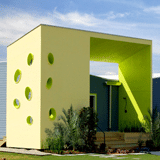When OceanSafe, a steel-structural-insulated-panel (SSIP) manufacturer with offices in New York and Louisiana, challenged eight architects to create a sustainable home as part of its 2010 design contest, all participants were given an identical building material list. “We gave each architect the exact same pieces and parts so their creativity would come through in their design,” says Joseph Basilice, the company’s president.
Do-it-all design
The regulations stipulated that the home should cost between $120,000 and $160,000 and should be capable of withstanding severe environmental conditions, including floods, earthquakes, and 160-mph hurricane winds.
The design was supposed to be able to collect enough rainwater and generate enough electrical power to support a family of five for up to seven days at a time between sustainable sun, wind, and geothermal ‘recharging’ periods.
Architects were asked to only use approved building materials, including OceanSafe’s SSIP panels, which, because they’re made of steel and firmly lock together into one unit, provide durable protection against tornados, earthquakes, and other natural disasters.
Making it happen
With all participating architects based in New Orleans—chosen due to the city’s Hurricane Katrina experience—the winning design came from Tulane University architecture professor Judith Kinnard and assistant professor Tiffany Lin. With the help of more than two dozen New Orleans construction professionals and vendors—product manufacturers donated all custom cabinetry, windows, doors, and other items—their Sunshower House design was constructed in the city’s Lakeview neighborhood between August 2011 and March 2012.
After the construction was completed, OceanSafe invited government officials from around the world to come to New Orleans to see the winning design. Government entities can view the Sunshower House and all other competition entries to see how SSIP homes can offer defense during a natural catastrophe and help countries meet urgent housing needs. “They are looking for something sustainable and green that they can stockpile [in preparation] for a disaster,” Basilice says. Governments from ten countries, including Haiti, Romania, Japan, and the Dominican Republic, plan to travel to New Orleans to discuss the competition entries with each architect.
Providing protection
SSIP structures protect against the elements, and they are mold- and termite-resistant and provide up to 70 percent more energy efficiency than standard homes. Basilice estimates a homeowner with a $400 electric bill could see costs reduced by $300 by moving into a SSIP home. “It’s like a structural walk-in freezer,” Basilice says. “Once the temperature is where it is, it stays there.”
Homeowners could receive insurance discounts for SSIP homes located in flood or high-wind zones. “The Earth may rattle, and the unit may sway or move, but the structure won’t collapse,” Basilice explains. And it can be built right out of a box; building-kit components come in a 42-foot-tall, 8-foot-wide cargo container.
SSIP revolution
OceanSafe, competition cosponsors Woodward Design+Build and C&G Construction, and sustainable design consultant The Regen Group have now formed REOSE, a company that packages and sells home-building kits with donated materials.
OceanSafe SSIP residences are currently being built in Louisiana, New York, Mississippi, Alabama, South Africa, and Iraq. The assembly time can vary, but construction typically takes four to five days for a 1,000-square-foot shell.
The company will also connect building-industry professionals, if needed. “We can work with any architectural drawings,” Basilice says. “If you have a building you want to look like a lighthouse, a Southern plantation, or a multistory condominium complex, we send it to our engineers, and they design it.”

